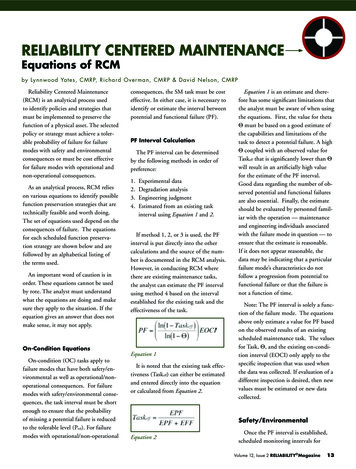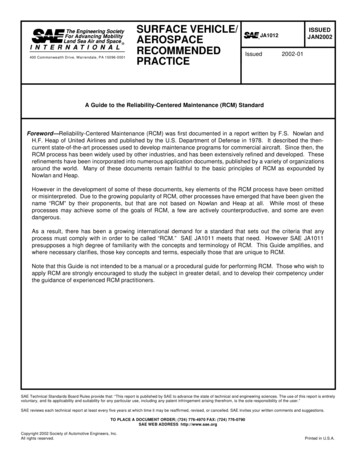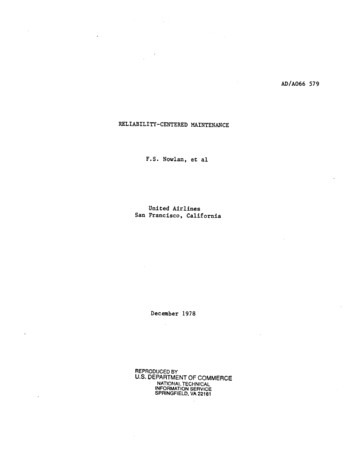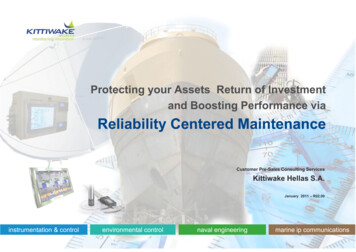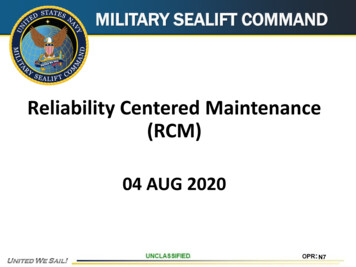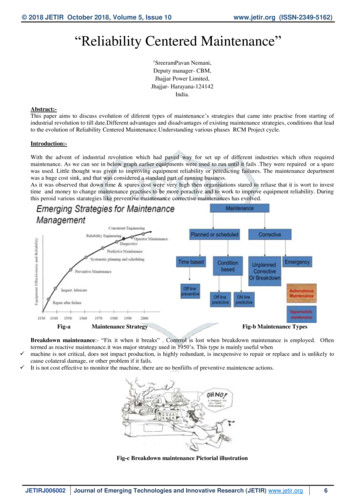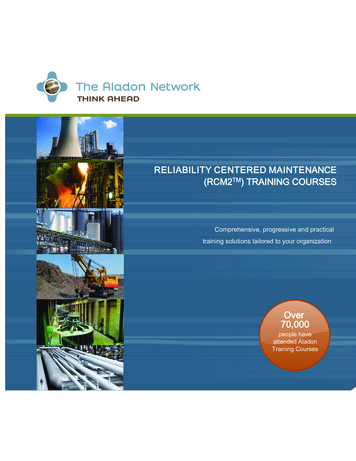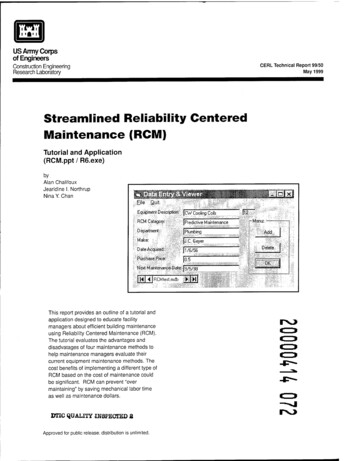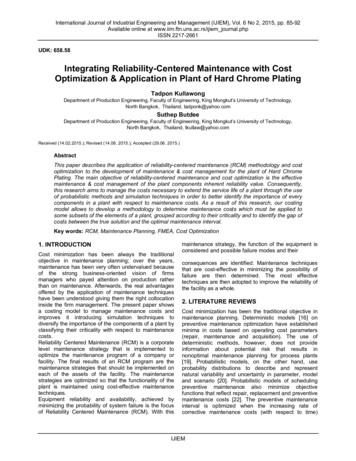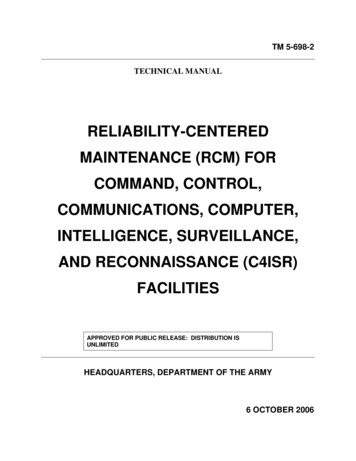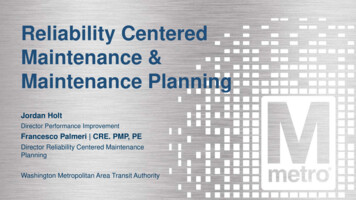
Transcription
Reliability Centered MaintenanceDifferent Implementation ApproachesHaidar Al HaianyCivil Engineering, masters level2016Luleå University of TechnologyDepartment of Civil, Environmental and Natural Resources Engineering
MASTER THESISRELIABILITY CENTERED MAINTENANCEDifferent Implementation ApproachesRCMHaidar Al HaianyLuleå/Sweden 2016Master of Science in Engineering TechnologyCivil EngineeringDivision of Operation and Maintenance EngineeringLuleå University of Technology
Haidar Al Haiany, 2016Examiner: Behzad GhodratiDepartment of Operation and MaintenanceLuleå University of TechnologySE-971 87 LuleåPhone: 46 (0) 920 49 10 00www.ltu.se
PREFACE AND ACKNOWLEDGEMENTThis research presented in this thesis has been carried out in the subject area of Operation andMaintenance Engineering at Luleå University of Technology (LTU), Luleå, Sweden. I wouldlike to thank my supervisor Behzad Ghodrati (Associated Professor in the Division of Operationand Maintenance Engineering at LTU) for providing support and resources for my masterthesis. I would also like to thank Associated Professor Alireza Ahmadi, Dr Hussan Al-Chalabi,Dr Ahmed Al-Rubaei, and all my teachers and friends in LTU.Special thanks for Khalid Habibi Alredha and Ali Badi for supporting me during my studyingat the university. I would also like to thank all my teachers in the municipality adult educationin Nordanstig commune, in Hälsningland (Annelie Nyrén, Magnus Danchwardt), and myfriends from Netherlands (Frans, Christine, and David).Special thanks to my family (my wife, my brother and sisters) for supporting during my lifeand for continues supporting. Special thanks to my beloved parents; my father Teacher AhmadAl Haiany and my mother Teacher Iman Al Haiany for supporting and teaching me and forcontinues helping.Haidar Al HaianyLuleå, SwedenAugust 20161I
II
ABSTRACTMining equipment are becoming very sophisticated and complex. At the same time, miningcompanies modernise its operation by increased mechanisation and automation (Dhillon, 2008).That requires well-developed and planned maintenance strategy. A proper maintenance strategyand appropriate maintenance actions, are essential to keep equipment safe & reliable, decreasethe overall costs, and it helps to eliminate workplace hazards.Maintenance strategies and maintenance actions, in turn, are changed and developed more thanany technology (Moubray, 1997). Changing and developing of the maintenance can be due tomany factors, perhaps due to the complexity of the systems or due to the development of thetechnology. One of the best research (developed technology) that has been done in this area isthe research by Nowlan and Heap about Reliability Centered Maintenance (RCM) in 1978.RCM is defined as, “a zero-based, structured process used to identify the failure managementstrategies required to ensure an asset meets its mission requirements in its operationalenvironment in the safest and cost – effective manner” (Regan, 2012). The RCM is one of thebest powerful asset management strategies. RCM can be applied to any asset, nuclear powerplant, aeroplane, or truck ship. According to (Nowlan & Heap, 1978), the main goal ofimplementation an RCM process is to provide the stated function of the facility with requiredreliability and availability at the lowest cost.In this master thesis, an RCM analysis process has been described in details. Moreover, twotypes of implementation approaches of an RCM analysis process have also been described. Theintention of describing these two approaches is to see what the differences between them areand which one can be recommended for using in mining. The first approach is according to(Hinchcliffe & Smith, 2004) and the second approach is according to (Regan, 2012). Moreover,in this master thesis, there are also two case studies that have been analysed. The intention ofanalysing these two case-studies is to see how the RCM has been implemented.As a result of the research carried out in this master thesis, some basic streamline RCM analysisprocess has been recommended for using in mining. This recommended RCM analysis processcould be applicable to be used in every industry section. The result of this work can besummarised that RCM is an applicable tool which can be used in mining for selecting the rightmaintenance approach for different equipment, systems or subsystem.RCM analysis process is discussed from different perspective. In the discussion, themisconceptions about the implementation of an RCM analysis process have been discussed.Altogether, Reliability Centered Maintenance is one of the most powerful asset managementstrategies that can be used in every industry section. If the RCM is applied by right people andby the right way, the result can be profitable for the mining companies.Keywords: Reliability Centered Maintenance, RCM, Implementation of RCM, RCM AnalysisProcess, RCM Implementation methodology.III
IV
SAMMANFATTNINGGruvutrustning och maskiner har blivit mycket sofistikerade och komplexa under de senasteåren. Samtidigt håller gruvföretagen på att modernisera sina verksamheter genom ökadmekanisering och automatisering (Dhillon, 2008). Detta kräver en väl utvecklad och planeradunderhållsstrategi. En riktig underhållsstrategi och en lämplig underhållsåtgärd är viktigt för atthålla utrustning säker och pålitlig samtidigt minskar de totala kostnaderna och bidrar till attrisker på arbetsplatsen elimineras.Underhållsstrategier och underhållsåtgärder, i sin tur, har förändrats och utvecklats mer ännågon annan teknik. Förändringen och utvecklingen kan bero på många faktorer, möjligtvis pågrund av komplexiteten i de nya systemen eller på grund av utvecklingen av tekniken(Moubray, 1997). En av de bästa forskningar (utvecklad teknik) som har gjorts på detta områdeär forskningen av Nowlan och Heap om Reliability Centered Maintenance (RCM) år 1978.RCM definieras som "en nollbaserad, strukturerad process för att identifiera strategier förhantering av fel som krävs för att säkerställa att en tillgång uppfyller de krav för uppdraget i sinoperativa miljö på det mest säkra och kostnadseffektiva sätt" (Regan, 2012). RCM är en av debästa kraftfulla strategierna och den kan tillämpas på alla tillgångar så som kärnkraftverk,flygplan, lastbil, eller fartyg. Enligt Nowlan & Heap (1978) är det viktigaste målet förgenomförandet av en RCM-process att ge den angivna funktionen av anläggningen mederforderlig tillförlitlighet och tillgänglighet till lägsta kostnad.I det här examensarbetet har RCM analysprocessen beskrivits i detaljer. Dessutom har två typerav implementeringsmetoder av en RCM analysprocess beskrivits. Avsikten med att beskrivadessa två metoder är att se vad skillnaderna är mellan dem och vilken som kan rekommenderasför användning i gruvdrift. Den första metoden är enligt Hinchcliffe & Smith (2004) och andraenligt Regan (2012). I detta examensarbete finns det även två fallstudier som har analyserats.Avsikten med att analysera dessa två fallstudier är ENBART för att se hur RCM har genomförts.I resultat av detta examensarbete, kan man se en rekommenderad RCM-metod som kananvändas för tillämplig av RCM i gruvdrift. Denna rekommenderade RCM-metod skulle kunnatillämpas för användning inom alla branscher. Resultatet av detta examensarbete kan ocksåsammanfattas genom att bekräfta att RCM är ett tillämpligt verktyg som kan användas igruvdrift för att välja rätt underhållsstrategi för olika utrustning, system eller delsystem.Sist men inte minst har RCM analysprocessen diskuteras utifrån olika perspektiv. Idiskussionen har missuppfattningar om genomförandet av en RCM analysprocess diskuterats.Sammantaget är Reliability Centered Maintenance en av de mest kraftfullaförvaltningsstrategier som kan användas inom alla branscher. Om RCM tillämpas av rättpersoner och på rätt sätt kan resultatet bli lönsamt för gruvföretagen.Nyckelord: Reliability Centered Maintenance, RCM, Genomförande av RCM, RCManalysprocessen, RCM genomförandemetod.V
VI
TABLE OF CONTENTSPREFACE AND ACKNOWLEDGEMENT. IABSTRACT . IIISAMMANFATTNING .V1INTRODUCTION . 11.11.1.1The Development of Maintenance . 21.1.2First Generation . 31.1.3Second Generation . 31.1.4Third Generation . 41.223BACKGROUND . 1MAINTENANCE MANAGEMENT AND STRATEGY . 51.2.1Preventive Maintenance PM . 61.2.2Corrective Maintenance CM . 61.2.3Reliability Centered Maintenance RCM . 61.3STATEMENT OF THE PROBLEM . 71.4PURPOSE OF THE RESEARCH . 71.5RESEARCH QUESTIONS AND OBJECTIVES . 71.6DELAMINATION . 7METHODOLOGY . 92.1PHASE 1: SELF-STUDY AND FINDING . 92.2PHASE 2: LITERATURE STUDY . 102.3PHASE 3: RCM IMPLEMENTATION APPROACHES . 112.4PHASE 4: SELECTION CRITERIA FOR THE CASE STUDIES . 12RELIABILITY CENTERED MAINTENANCE (RCM) . 133.1INTRODUCTION TO RCM . 133.1.1Definitions . 143.1.2Purpose . 143.1.3Benefits . 143.1.4Goals . 153.2THE HISTORY OF RCM . 153.3THE EVOLUTION OF RCM . 163.4DIFFERENT TYPES OF RCM . 193.4.1Rigorous . 193.4.2Intuitive (streamlined) . 193.5RCM PRINCIPLES AND KEY FEATURES . 203.6SYSTEM INFLUENCING FACTORS IN CONTEXT OF RCM. 213.7EQUIPMENT CRITICALITY & RISK ANALYSIS. 223.7.1Risk Priority Number (RPN) . 233.8FAILURE MODES AND EFFECT CRITICALITY ANALYSIS (FMEA & FMECA) . 243.9RCM IMPLEMENTATION, HINCHCLIFFE & SMITH APPROACH. 253.9.1Step 1: System selection and information collection . 253.9.2Step 2: System boundary definition . 26VII
3.9.3Step 3: System description and functional block diagram . 263.9.4Step 4: System Functions and Functional Failure . 263.9.5Step 5: Failure Mode and Effects Analysis, FMEA . 273.9.6Step 6: Logic tree analysis; prioritize function need via failure modes . 273.9.7Step 7: Task selection . 28RCM IMPLEMENTATION, REGAN APPROACH . 293.103.10.1RCM Operating Context . 293.10.2RCM Seven Questions . 313.10.2.1Functions . 313.10.2.2Functional Failure. 333.10.2.3Failure Mode . 333.10.2.4Failure Effect . 343.10.2.5Failure Consequence . 353.10.2.6Proactive Maintenance and Intervals . 383.10.2.7Default Strategies . 44RCM OUTSOURCING AND BENCHMARKING. 463.114RESULT . 494.1567ANALYSING AND SELECTING PROCEDURE OF THE CASE STUDIES . 494.1.1Analysed case-study 1 . 504.1.2Analysed case-study 2 . 514.2RCM IMPLEMENTATION CRITERIA . 524.3RIGOROUS IMPLEMENTATION APPROACH . 534.4SUGGESTED IMPLEMENTATION APPROACH . 54DISCUSSION . 555.1ISSUES AND CHALLENGES OF RCM IMPLEMENTATION . 555.2MISCONCEPTIONS OF RCM . 575.3RCM VS FMEA . 575.4MYTHS OF RCM IMPLEMENTATION . 585.4.1Does RCM solve all reliability problems of a company? . 585.4.2There will be no more failures after applying RCM? . 585.4.3It is hard to define systems and functions in RCM . 585.4.4Application of RCM should start from the current maintenance plan. 58CONCLUSION AND FURTHER WORK . 596.1CONCLUSION . 596.2FURTHER WORK . 59REFERENCES . 60VIII
LIST OF APPENDIXAppendix 1Appendix 2Appendix 3Appendix 4Appendix 5Appendix 7Appendix 8Appendix 9Appendix 10Glossary . iSteps to Initiate an RCM Program (Regan, 2012) . ivThe RCM Process (Regan, 2012) . vRCM information Worksheet I (Regan, 2012). viRCM Decision Worksheet II (Regan, 2012) . viiRCM Decision diagram, Hidden Failure Mode (Regan, 2012) . ixFailure Mode and Effect Analysis FMEA . xRCM implementation approach (hinchcliffe & Smith, 2004) . xiTask selection (hinchcliffe & Smith, 2004) . xiiIX
LIST OF FIGURESFigure 1-1 Typical mining drift mining process (Hamodi, 2014) . 2Figure 1-2 The evolution of maintenance (Moubray, 1997) . 3Figure 1-3 Traditional view of Failure, first generation (Moubray, 1997) . 3Figure 1-4 Traditional thinking of Failure occurrence, second generation (Moubray, 1997) . 3Figure 1-5 Failure patterns (Moubray, 1997) . 4Figure 1-6 Maintenance overview chart according to (EN 13 306, 2001) . 5Figure 2-1 Phase 1-1: desire, idea and choice . 9Figure 2-2 Phase 1-2: The aid by university studies . 10Figure 2-3 Phase 2: The aid by different courses . 11Figure 2-4 Phase 3: RCM different implementation approaches . 11Figure 2-5 Phase 4: Criteria for selection for the case studies . 12Figure 3-1 Traditional view of failure (Regan, 2012) . 16Figure 3-2 Example of a shortened overhaul interval (Regan, 2012). 16Figure 3-3 Six patterns of failure (Regan, 2012) . 17Figure 3-4 Percentages of Failure Modes that conformed to Failure Pattern (Regan, 2012) . 18Figure 3-5 Percentages of Failure Modes conformed to Failure Pattern B (Regan, 2012) . 18Figure 3-6 Percentages of Failure Modes that conformed to Failure Pattern F (Regan, 2012) . 18Figure 3-7 Reintroducing infant mortality (Regan, 2012) . 18Figure 3-8 Failure management strategies (Adapted from Regan, 2012) . 21Figure 3-9 Risk Assessment . 22Figure 3-10 Logic tree analysis structure (Adapted from Hinchcliffe & Smith, 2004) . 27Figure 3-11 System description . 30Figure 3-12 Including RCM functions (Adapted from Regan, 2012) . 32Figure 3-13 Include failure mode in RCM analysis (Adapted from Regan, 2012) . 34Figure 3-14 Determining if a Failure Mode is Evident or Hidden (Adapted from Regan, 2012) . 35Figure 3-15 Safety consequences (Adapted from Regan, 2012) . 36Figure 3-16 Environmental consequences. (Adapted from Regan, 2012) . 36Figure 3-17 Operational consequences (Adapted from Regan, 2012) . 37Figure 3-18 Proactive Maintenance . 38Figure 3-19 Intention of Preventive Maintenance . 38Figure 3-20 Proactive Maintenance in the context of RCM (Adapted from Regan, 2012) . 39Figure 3-21 Criteria for assigning proactive maintenance tasks . 40Figure 3-22 Assigning preventive maintenance / Useful life . 40Figure 3-23 Restoration and Replacement (Adapted from Regan, 2012) . 41Figure 3-24 On-Condition maintenance, P-F Interval . 42Figure 3-25 On-Condition maintenance, Net P-F Interval . 42Figure 3-26 On-condition maintenance interval (Adapted from Regan, 2012) . 43Figure 3-27 Combination of Tasks (Adapted from Regan, 2012) . 43Figure 3-28 Procedural Check for Evident Failure Mode (Adapted from Regan, 2012) . 44Figure 3-29 Failure finding Task for Hidden Failure Mode (Adapted from Regan, 2012) . 45Figure 3-30 Reasons for outsourcing (the 2001 outsourcing world summit) . 46Figure 3-31 RCM Outsourcing (Adapted from Benchmarking report, 2015) . 47Figure 3-32 RCM Benchmarking (Adapted from Bench marking report, 2015) . 47Figure 4-1 Analysing questions. 49Figure 4-2 Rigorous implementation process . 53Figure 4-3 Suggested RCM Pilot Project . 54X
ABBREVIATIONAAvailabilityCACriticality AnalysisCBMCondition Based MaintenanceCMCorrective MaintenanceCMMSComputerized Maintenance Management SystemDDetectionFMEAFailure Mode and Effects AnalysisFMECAFailure Mode, Effects and Criticality AnalysisIPPImpact per PublicationLCCLife Cycle CostLCPLife Cycle ProfitLTALogic Tree -To-FailureMTTRMean-Time-To-RepairOEMOriginal Equipment ManufacturingOCCOccurrencePaMProactive MaintenancePdMPredictive MaintenancePMPreventive maintenanceRCARoot-Cause AnalysisRCMReliability-Centered MaintenanceRMRisk ManagementRPNRisk Priority NumberRTFRun to FailureSSafetySEVSeverityTPMTotal Productive MaintenanceXI
XII
1INTRODUCTIONThis chapter deals with the background of mining equipment maintenance, development ofmaintenance and maintenance strategies. It is aimed to introduce the Reliability CenteredMaintenance which in turn will be described in details in chapter three. This chapter also dealswith the statement of the problems, purpose of the thesis, and the research questions. By theend of this chapter, the delimitations will also be defined.1.1 BackgroundThere are many people are working in mining industries throughout the world. Only in theUSA, there are more than 675,000 peoples are employed in the natural resources and miningsector (Dhillon, 2008). Each year, many billions of dollars are spent on manufacturing differenttypes of equipment for use by the mining industries around the world.By the time, mining equipment is becoming very sophisticated and complex. That leads to,increasing of operation- and maintenance costs. Besides, governments and organisationsrequire that mining equipment must be safer for the operator and environment-friendly. Miningcompanies need also modernise its operation by increased mechanisation and automation(Dhillon, 2008).Therefore, a proper maintenance is essential to keep equipment safe and reliable and it helps toeliminate workplace hazards. It is important, a proper maintenance program is in the place andall maintenance work is risk assessed before beginning the work. Then, the cost of maintenancemust be plausible in order to mining companies meets the goals in their business strategy.Without proper maintenance, the workplace will not be safe and mining equipment will sufferand the cost of maintenance will increase. Therefore, it is needed to maintain the equipment asit needs and continuously improve the maintenance methods. According to (Dhillon, 2008), thefollowing facts are related directly or indirectly to mining equipment maintenance;1- Over 25% of the accidents in underground coal mining occur during maintenance activity.2- The total annual cost of engineering maintenance is approx. 450 million in the Australianunderground coal mining industry.3- Approximately 10% of production time is lost by unplanned maintenance in Australianunderground coal mining industry.4- Usually, the cost of maintenance in the mining industry varies from 40% to 50% of theequipment operating cost.5- Equipment maintenance costs range from 20% to over 35% of total mine operating costs.6- According to civilian and military studies, it is possible to reduce preventive maintenanceand corrective maintenance tasks times by 40% to 70% with planned maintainability designefforts.
In specific point of view or from the production perspective, mining equipment is essential andcritical. In undergrou
Altogether, Reliability Centered Maintenance is one of the most powerful asset management strategies that can be used in every industry section. If the RCM is applied by right people and by the right way, the result can be profitable for the mining companies. Keywords: Reliability Centered Maint
